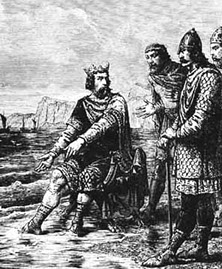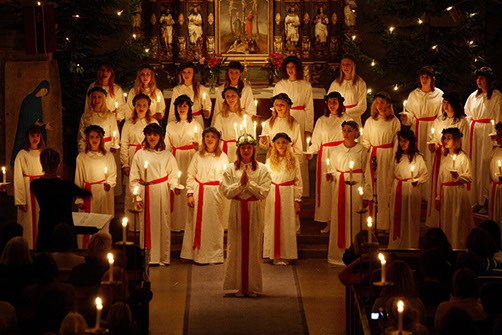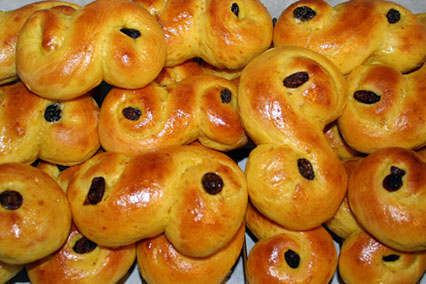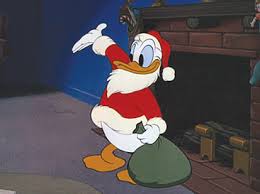Welcome To Christmas Around The World
Learn How Other Children Celebrate Christmas From Different Countries!
Christmas In Sweden
Say Merry Christmas in Swedish
God Jul!
 A thousand years ago in Sweden, King Canute declared that Christmas would last a month, from December 13, the feast of St. Lucia until January 13, or Tjugondag Knut (St. Canute's Day). No one is quite sure why Lucia, a 4th century Sicilian saint, came to be so revered in Sweden. Some say she once visited the country, and others believe missionaries brought stories of her life which entranced the Swedish people. Her story is that in the days of early Christian persecution, Lucia carried food to Christians hiding in dark underground tunnels. To light the way she wore a wreath of candles on her head. Eventually Lucia was arrested and martyred.
A thousand years ago in Sweden, King Canute declared that Christmas would last a month, from December 13, the feast of St. Lucia until January 13, or Tjugondag Knut (St. Canute's Day). No one is quite sure why Lucia, a 4th century Sicilian saint, came to be so revered in Sweden. Some say she once visited the country, and others believe missionaries brought stories of her life which entranced the Swedish people. Her story is that in the days of early Christian persecution, Lucia carried food to Christians hiding in dark underground tunnels. To light the way she wore a wreath of candles on her head. Eventually Lucia was arrested and martyred.
On her feast day the eldest daughter in each family dresses in a white dress with a red sash, and wears an evergreen wreath with seven lighted candles on her head. She (very carefully) carries coffee and buns to each family member in his or her room. Many schools, offices, and communities sponsor Lucia processions in which carol are sung and everyone thanks the Queen of Light for bringing hope during the darkest time of the year.
On Christmas Eve a certain Christmas gnome, known as the tomte, emerges from his home under the floor of the house or the barn. He carries a sack over his shoulder and leaves gifts for all.
 Around Christmas time in Sweden, one of the biggest celebrations is St. Lucia's Day (or St. Lucy's Day) on December 13th. The celebration comes from stories that were told by Monks who first brought Christianity to Sweden.
Around Christmas time in Sweden, one of the biggest celebrations is St. Lucia's Day (or St. Lucy's Day) on December 13th. The celebration comes from stories that were told by Monks who first brought Christianity to Sweden.
St Lucia was a young Christian girl who was martyred, killed for her faith, in 304AD. The most common story told about St Lucia is that she would secretly bring food to the persecuted Christians in Rome, who lived in hiding in the catacombs under the city. She would wear candles on her head so she had both her hands free to carry things. Lucy means 'light' so this is a very appropriate name.
December 13th was also the Winter Solstice, the shortest day of the year, in the old 'Julian' Calendar and a pagan festival of lights in Sweden was turned into St. Lucia's Day.
St. Lucia's Day is now celebrated by a girl dressing in a white dress with a red sash round her waist and a crown of candles on her head. Small children use electric candles but from about 12 years old, real candles are used!
The crown is made of Lingonberry branches which are evergreen and symbolize new life in winter. Schools normally have their own St. Lucia's and some town and villages also choose a girl to play St. Lucia in a procession where carols are sung.
A national Lucia is also chosen. Lucias also visit hospitals and old people's homes singing a song about St Lucia and handing out 'Pepparkakor', ginger snap biscuits.
Small children sometimes like dressing up as Lucia (with the help of their parents!). Also boys might dress up as 'Stjärngossar' (star boys) and girls might be 'tärnor' (like Lucia but without the candles).
 A popular food eaten at St. Lucia's day are 'Lussekatts', St Lucia's day buns flavoured with saffron and dotted with raisins which are eaten for breakfast.
A popular food eaten at St. Lucia's day are 'Lussekatts', St Lucia's day buns flavoured with saffron and dotted with raisins which are eaten for breakfast.
St Lucia's Day first became widely celebrated in Sweden in the late 1700s. St Lucia's Day is also celebrated in Denmark, Norway, Finland, Bosnia, and Croatia. In Denmark it is more a of a children's day and in some part of Italy, children are told that St Lucy brings them presents. They leave out a sandwich for her and the donkey that helps carry the gifts!
Christmas Eve is also very important in Sweden. This is when the main meal (well really a feast!) is eaten.
This is often a 'julbord' which is a buffet, eaten at lunchtime. Cold fish is important on the julbord. There is often herring (served in many different ways), gravlax (salmon which has been cured in sugar, salt and dill) and smoked salmon.
Other dishes on the julbord might include cold meats including turkey, roast beef and 'julskinka' (a Christmas ham); cheeses, liver pate, salads, pickles and different types of bread and butter (or mayonnaise). There will also be warm savoury foods including meatballs, 'prinskorv' (sausages), 'koldomar' (meat stuffed cabbage rolls), jellied pigs' feet, lutfisk (a dried cod served with a thick white sauce) and 'revbenspjäll' (oven-roasted pork ribs). Vegetables such as potatoes and red cabbage will also be served. Another potato dish is 'Janssons Frestelse' (matchstick potatoes layered with cream, onion and anchovies that is baked to a golden brown). There's also 'dopp i grytan' which is bread that is dipped in the broth and juices that are left over after boiling the ham.
The desert of the julbord might be a selection of sweet pastries, some more pepparkakor biscuits and some home made sweets!
Wow, I think I like the sound of a Jolbord! To wash all that food down you can have some 'glogg' which is sweet mulled wine and some coffee to finish off the meal!
Another popular food at Christmas in Sweden is 'risgrynsgröt' (rice porridge that's eaten with 'hallonsylt' [raspberry jam] or sprinkled with some cinnamon). It's often eaten during the evening after people have exchanged their presents.
If there is any risgrynsgröt left over, when it's cold it can be mixed with whipped cream and eaten with a warm fruit sauce. This is called 'Ris a la malta' and sounds rather yummy!
Presents are normally exchanged on Christmas Eve. People often go to Church early on Christmas morning.
 Another popular and important that many Swedes do on Christmas Eve afternoon is to watch Donald Duck! Every year, since 1959, at 3.00pm on Christmas Eve, the TV station TV1 shows the Disney special "From All of Us to All of You" or in Swedish it's "Kalle Anka och hans vänner önskar God Jul" meaning "Donald Duck and his friends wish you a Merry Christmas." About 40 to 50% of the Swedish population stop to watch it!
Another popular and important that many Swedes do on Christmas Eve afternoon is to watch Donald Duck! Every year, since 1959, at 3.00pm on Christmas Eve, the TV station TV1 shows the Disney special "From All of Us to All of You" or in Swedish it's "Kalle Anka och hans vänner önskar God Jul" meaning "Donald Duck and his friends wish you a Merry Christmas." About 40 to 50% of the Swedish population stop to watch it!
Families sometimes have goats made of straw in the house to guard the Christmas Tree! Straw is used as a decoration in homes, to remind them that Jesus was born in a manger. Christmas Tree decorations that are made of straw are also very popular. In the city of Gävle, a huge straw goat is built every year for the start of Advent. It takes two days to put up!
In Sweden, presents might be brought by Santa called 'Jultomten' or by gnomes/elves called 'Nissar' or 'Tomte'. They're called Nisse' in Norway.
The end of Christmas in Sweden is on January 13th (twenty days after Christmas) which is called 'Tjugondag Knut' (Twentieth Day Knut) or 'Tjugondag jul' (Twentieth Day Yule) and is named after a Danish prince called Canute Lavard. On Tjugondag Knut it's traditional that the christmas Tree is taken down and and left over cookies and sweets are eaten!



Copyright © 1996 THE-NORTH-POLE.COM Designed by LeNewit.com
HOME | ABOUT | PRIVACY POLICY | TERMS OF USE | CONTACT US

